This blog article is in conversation with Onome Ako,
CEO of Action Against Hunger Canada.
As the hunger crisis in the Horn of Africa grows and emergency funding falls short, the work of Action Against Hunger Canada is more important than ever.
Flying to the Somali Region of Ethiopia last year, Onome Ako, CEO of Action Against Hunger Canada, got a first-hand glimpse into the devastating drought that’s been plaguing millions of people in East Africa for years. The images are burned into her mind.
“There were dry riverbeds everywhere, carcasses of animals spread out as well…we were actually trying to make out the dead animals, you know, is this a goat, or is this a camel, or what is this?” she recalls.
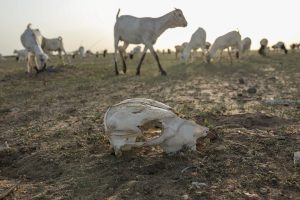
“I visited a camp that had about 4,000 men, women and children in it…Normally, you will see a camp that has been set up because of conflict or a fast-onset disaster. But in this case, you had a camp created from a long-term drought as a result of the ongoing climate crisis,” she adds.
“I was thinking what would have been in a family’s mind as they left their belongings, their animals, to go in search of basic needs like water or food.”
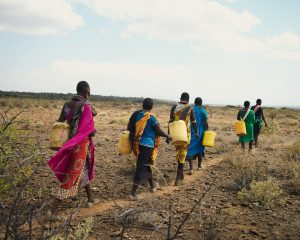
In June of 2022, the World Health Organization (WHO) classified the drought in the Horn of Africa (the worst in four decades) as a Grade 3 emergency, the agency’s highest crisis ranking. This past February, with the release of their 2023 Hunger Funding Gap Report, Action Against Hunger warned of a potential sixth failed rainy season.
What’s Causing the Hunger Crisis in East Africa?
Extreme drought has decimated crops and livestock, leading to severe and widespread food and water shortages, while unclean drinking water has caused countless people to fall ill with cholera, diarrhea and other waterborne diseases. For those areas that have been fortunate enough to receive rain, flash floods have washed away any crops that are left, further devastating livelihoods.
Climate change and its wide-reaching effects are just one of the causes of the worst hunger crisis seen in 40 years in the Horn of Africa, affecting about 32 million people. And it shows no signs of slowing anytime soon. The past three years have been particularly difficult, Ako says, especially in Ethiopia, Kenya and Somalia, with about 4.9 million children that are severely malnourished. In Somalia alone, she says, Action Against Hunger has seen a 50 per cent increase in malnutrition admissions at their health centres since 2021.
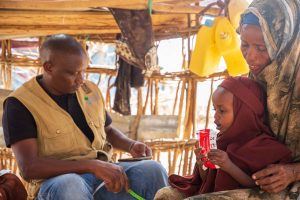
“In the whole of East Africa, you have about 15 million boys and girls that are already out of school, also as a result of the hunger crisis,” she adds.
Further exacerbating the crisis is the profound socio-economic impacts of the COVID-19 pandemic and ongoing internal conflict and instability throughout the region, Ako says, which has been disrupting farming and making it challenging to deliver humanitarian aid. In Sudan, for example, some 250,000 people have had to flee to neighbouring countries like Ethiopia and South Sudan, “where food insecurity is already high,” she says. “So it’s kind of a challenge on top of a challenge.”
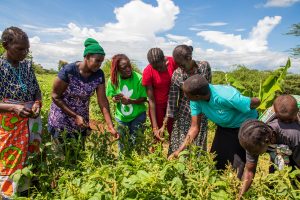
And then there’s the conflict in Ukraine, which has swiftly sent food and energy prices soaring. Over 40 per cent of the wheat that’s used in Africa comes from Ukraine, Ako says, “So staples like bread just skyrocketed. And fuel prices as well have had a major impact on transportation costs, on fertilizers, on shipping, making it more expensive for people to afford meals to meet their basic needs.”
Long-Term Solutions Equal Long-Term Resilience
The hunger crisis is a huge and complicated issue with no simple solution. And with emergency funding falling far short of where it needs to be, the work of Action Against Hunger Canada is becoming increasingly vital. Their Hunger Funding Gap Report notes: “None of the four countries in the Horn of Africa that we analyzed had UN appeals for hunger funding fulfilled in 2022, even though a growing number of people are on the brink of famine.”
Active in the Horn of Africa for over 40 years (including Ethiopia, Kenya, Somalia, Sudan, South Sudan, Tanzania and Uganda), the organization has deep roots within the region, Ako says, “and we have our colleagues who are actually from the communities that we work in, and they’ve developed a relationship of trust.”
Fight hunger by starting at the root cause
With a mission to fight hunger and its root causes worldwide, the organization has taken a multi-pronged approach in East Africa, with a primary focus on saving lives, Ako says, especially in emergency situations. This includes detecting and treating malnourished children, providing essential medicines and vaccines at health centres and mobile health units, providing water through borehole and water pump rehabilitation, as well as hygiene and water purification kits to help prevent disease outbreaks. They also provide psychosocial supports to communities and direct cash transfers to farmers, small businesses and families, “because cash also brings about the ability to make a choice and brings dignity to individuals,” Ako says.
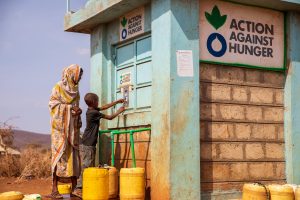
Community Building is at the core of solving the hunger crisis
Rather than a band-aid approach, Action Against Hunger Canada works together with communities to identify solutions, which can include equipping communities with tools, skills and knowledge to help them build long-term resilience in the face of the hunger crisis. This has taken the form of everything from livelihood support, small-scale irrigation, certified seeds and livestock provision, to providing or introducing climate-resilient agricultural techniques and technology like solar powered irrigation systems.
As women eat least and last in many of the communities they work in, Ako adds, the organization also does advocacy around gender equity and equality, and works with communities to promote financial inclusion and abandon harmful practices like female genital mutilation and child marriage – ensuring their programs are established within existing systems in communities where they work.
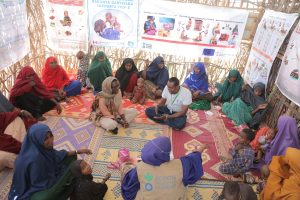
This community-centred approach, Ako says, which prioritizes engaging and working with communities to identify their needs, is paramount to their work. For example, one of Action Against Hunger’s initiatives supplied a group of women with a breed of goat that could withstand hot climates.
“The women actually came up with an idea of starting a business, and we supported with seed funding. So through the business, the goats provided nutritious milk for the families, they were able to sell it, they were able to earn extra income, they were able to buy essential things that they needed, as well as send their children to school,” she says.
“We rely on the local communities we work with. We work hand in hand with them, because they also know the challenges that they’re facing and we rely on the local knowledge that they bring and on coming up with long-term solutions that are right for their community.”
Anchored in Hope
Of course, donor contributions have been crucial to Action Against Hunger Canada’s work and mission. As the saying goes, it takes a village.
“I’m really grateful for the contributions that we get at Action Against Hunger, because there are so many organizations that donors give to,” Ako says.
These donations have helped save millions of lives by allowing the organization to act swiftly in providing urgent treatment and intervention, and helping them treat malnutrition and provide essential nutrition for children, medical care, shelter and water.
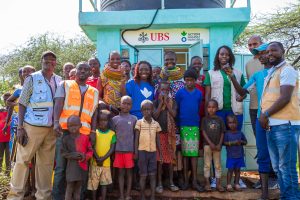
“Donations from Canadians will help people survive in crisis. It will help them rebuild their lives. And most importantly, it will help them thrive within their communities,” Ako says.
The Hunger Funding Gap Report states that “It would take $4 billion to fully fund the hunger-related appeals of the 13 countries in this report,” which includes Afghanistan, Central African Republic, Democratic Republic of Congo, Ethiopia, Guatemala, Haiti, Honduras, Kenya, Madagascar, Mozambique, Pakistan, Somalia and Sudan.
“This can be raised because this is basically a quarter of what the American public bets on the Super Bowl. It’s the estimated cost of the 2030 Winter Olympics,” Ako says.
“So it’s doable, if we have the will to do it.”
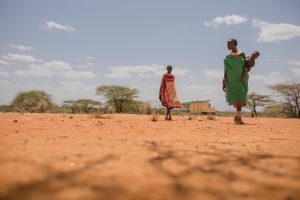
In the face of a seemingly impossible situation, Ako remains positive. A big part of that comes from what she’s seen from local people on the ground in the communities where they work. For example, she recalls a woman who offered up her land to be used as a demonstration farm for the benefit of others. She’s been touched by people’s spirit of generosity and kindness.
Whether it’s Canada, Kenya or Côte d’Ivoire, Ako says, a common thread is people’s incredible strength and resilience. “It’s their never-ending resolve to support their families, their communities, despite everything that they go through,” she says.
“Out of nothing, individuals continue to give and I think for me, it just reminds me that despite everything, hope is always possible.”
Take Action!
Help fuel the work of organizations providing support to countries impacted by the
East African hunger crisis or learn more about Action Against Hunger Canada.

Leave a Reply